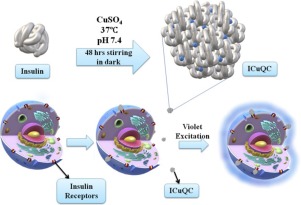当前位置:
X-MOL 学术
›
Colloids Surf. B Biointerfaces
›
论文详情
Our official English website, www.x-mol.net, welcomes your
feedback! (Note: you will need to create a separate account there.)
Insulin-copper quantum clusters preparation and receptor targeted bioimaging.
Colloids and Surfaces B: Biointerfaces ( IF 5.4 ) Pub Date : 2020-01-09 , DOI: 10.1016/j.colsurfb.2020.110785 Pawandeep Kaur 1 , Sunidhi Sharma 1 , Satabdi Datta Choudhury 2 , Deepika Singh 1 , Shreya Sharma 1 , Kundlik Gadhave 3 , Neha Garg 3 , Diptiman Choudhury 1
Colloids and Surfaces B: Biointerfaces ( IF 5.4 ) Pub Date : 2020-01-09 , DOI: 10.1016/j.colsurfb.2020.110785 Pawandeep Kaur 1 , Sunidhi Sharma 1 , Satabdi Datta Choudhury 2 , Deepika Singh 1 , Shreya Sharma 1 , Kundlik Gadhave 3 , Neha Garg 3 , Diptiman Choudhury 1
Affiliation

|
Protein embedded fluorescence quantum clusters (QCs) have received a great amount of interest among the researchers because of their high aqueous solubility, stability, cost efficiency, and target specificity. Considerable advancement has happened in making functional quantum clusters with target specificity. This work reports the simple synthesis of insulin protected copper quantum clusters (ICuQCs) and its receptor-targeted bioimaging applications. The preparation of copper quantum clusters (CuQCs) was done simply by one-pot synthesis method by changing the pH of the insulin protein firstly to 10.5 basic pH than physiological pH. At physiological pH, the mixture incubated in oven 37 ⁰C at 240 rpm has been developed to process initially polydisperse, non-fluorescent, and unstable CuDs into monodispersed (∼2-3 nm), highly fluorescent, and extremely stable ICuQCs in the same phase (aqueous) using insulin as protein. HRTEM image show uniform distribution of CuDs within the protein matrix. Metal ion binding site prediction and docking server (MIB) results show that chain B of insulin contains 3 templates contains 5 amino acid residues which bind with Cu2+ metal ion. Groove 1 contains GLY8 and HIS10 bind has the highest binding potential towards Cu metal ions. The methodology adopted in this study should largely contribute to the practical applications of this new class of QCs. In view of the protein protection, coupled with direct synthesis and easy functionalization, this hybrid QC-protein system is expected to have numerous optical and bioimaging applications in the future.
中文翻译:

胰岛素-铜量子簇的制备和受体靶向生物成像。
蛋白质嵌入的荧光量子簇(QC)由于其高的水溶性,稳定性,成本效率和靶标特异性而受到了研究人员的广泛关注。在制备具有靶标特异性的功能量子簇方面已经取得了相当大的进步。这项工作报告了胰岛素保护的铜量子簇(ICuQCs)的简单合成及其受体靶向的生物成像应用。通过一锅法合成铜量子簇(CuQCs)的方法很简单,首先将胰岛素蛋白的pH值更改为比生理pH值高10.5的碱性pH。在生理pH下,已经开发出了在37℃烘箱中以240 rpm孵育的混合物,可以将最初的多分散,无荧光和不稳定的CuDs处理成单分散(〜2-3 nm),高荧光,使用胰岛素作为蛋白质,在同一相(水溶液)中具有非常稳定的ICuQC。HRTEM图像显示CuDs在蛋白质基质中的均匀分布。金属离子结合位点预测和对接服务器(MIB)结果表明,胰岛素链B包含3个模板,该模板包含5个与Cu2 +金属离子结合的氨基酸残基。包含GLY8和HIS10结合的凹槽1对铜金属离子的结合力最高。本研究中采用的方法应在很大程度上有助于此类新型质量控制的实际应用。考虑到蛋白质的保护以及直接合成和容易的功能化,该混合QC-蛋白质系统有望在未来具有大量的光学和生物成像应用。HRTEM图像显示CuDs在蛋白质基质中的均匀分布。金属离子结合位点预测和对接服务器(MIB)结果表明,胰岛素链B包含3个模板,该模板包含5个与Cu2 +金属离子结合的氨基酸残基。包含GLY8和HIS10结合的凹槽1对铜金属离子的结合力最高。本研究中采用的方法应在很大程度上有助于这类新型质量控制的实际应用。考虑到蛋白质的保护以及直接合成和容易的功能化,该混合QC-蛋白质系统有望在未来具有大量的光学和生物成像应用。HRTEM图像显示CuDs在蛋白质基质中的均匀分布。金属离子结合位点预测和对接服务器(MIB)结果表明,胰岛素链B包含3个模板,该模板包含5个与Cu2 +金属离子结合的氨基酸残基。包含GLY8和HIS10结合的凹槽1对铜金属离子的结合力最高。本研究中采用的方法应在很大程度上有助于这类新型质量控制的实际应用。考虑到蛋白质的保护以及直接合成和容易的功能化,该混合QC-蛋白质系统有望在未来具有大量的光学和生物成像应用。金属离子结合位点预测和对接服务器(MIB)结果表明,胰岛素链B包含3个模板,该模板包含5个与Cu2 +金属离子结合的氨基酸残基。包含GLY8和HIS10结合的凹槽1对铜金属离子的结合力最高。本研究中采用的方法应在很大程度上有助于此类新型质量控制的实际应用。考虑到蛋白质的保护以及直接合成和容易的功能化,该混合QC-蛋白质系统有望在未来具有大量的光学和生物成像应用。金属离子结合位点预测和对接服务器(MIB)结果表明,胰岛素链B包含3个模板,该模板包含5个与Cu2 +金属离子结合的氨基酸残基。包含GLY8和HIS10结合的凹槽1对铜金属离子的结合力最高。本研究中采用的方法应在很大程度上有助于此类新型质量控制的实际应用。考虑到蛋白质的保护以及直接合成和容易的功能化,该混合QC-蛋白质系统有望在未来具有大量的光学和生物成像应用。
更新日期:2020-01-09
中文翻译:

胰岛素-铜量子簇的制备和受体靶向生物成像。
蛋白质嵌入的荧光量子簇(QC)由于其高的水溶性,稳定性,成本效率和靶标特异性而受到了研究人员的广泛关注。在制备具有靶标特异性的功能量子簇方面已经取得了相当大的进步。这项工作报告了胰岛素保护的铜量子簇(ICuQCs)的简单合成及其受体靶向的生物成像应用。通过一锅法合成铜量子簇(CuQCs)的方法很简单,首先将胰岛素蛋白的pH值更改为比生理pH值高10.5的碱性pH。在生理pH下,已经开发出了在37℃烘箱中以240 rpm孵育的混合物,可以将最初的多分散,无荧光和不稳定的CuDs处理成单分散(〜2-3 nm),高荧光,使用胰岛素作为蛋白质,在同一相(水溶液)中具有非常稳定的ICuQC。HRTEM图像显示CuDs在蛋白质基质中的均匀分布。金属离子结合位点预测和对接服务器(MIB)结果表明,胰岛素链B包含3个模板,该模板包含5个与Cu2 +金属离子结合的氨基酸残基。包含GLY8和HIS10结合的凹槽1对铜金属离子的结合力最高。本研究中采用的方法应在很大程度上有助于此类新型质量控制的实际应用。考虑到蛋白质的保护以及直接合成和容易的功能化,该混合QC-蛋白质系统有望在未来具有大量的光学和生物成像应用。HRTEM图像显示CuDs在蛋白质基质中的均匀分布。金属离子结合位点预测和对接服务器(MIB)结果表明,胰岛素链B包含3个模板,该模板包含5个与Cu2 +金属离子结合的氨基酸残基。包含GLY8和HIS10结合的凹槽1对铜金属离子的结合力最高。本研究中采用的方法应在很大程度上有助于这类新型质量控制的实际应用。考虑到蛋白质的保护以及直接合成和容易的功能化,该混合QC-蛋白质系统有望在未来具有大量的光学和生物成像应用。HRTEM图像显示CuDs在蛋白质基质中的均匀分布。金属离子结合位点预测和对接服务器(MIB)结果表明,胰岛素链B包含3个模板,该模板包含5个与Cu2 +金属离子结合的氨基酸残基。包含GLY8和HIS10结合的凹槽1对铜金属离子的结合力最高。本研究中采用的方法应在很大程度上有助于这类新型质量控制的实际应用。考虑到蛋白质的保护以及直接合成和容易的功能化,该混合QC-蛋白质系统有望在未来具有大量的光学和生物成像应用。金属离子结合位点预测和对接服务器(MIB)结果表明,胰岛素链B包含3个模板,该模板包含5个与Cu2 +金属离子结合的氨基酸残基。包含GLY8和HIS10结合的凹槽1对铜金属离子的结合力最高。本研究中采用的方法应在很大程度上有助于此类新型质量控制的实际应用。考虑到蛋白质的保护以及直接合成和容易的功能化,该混合QC-蛋白质系统有望在未来具有大量的光学和生物成像应用。金属离子结合位点预测和对接服务器(MIB)结果表明,胰岛素链B包含3个模板,该模板包含5个与Cu2 +金属离子结合的氨基酸残基。包含GLY8和HIS10结合的凹槽1对铜金属离子的结合力最高。本研究中采用的方法应在很大程度上有助于此类新型质量控制的实际应用。考虑到蛋白质的保护以及直接合成和容易的功能化,该混合QC-蛋白质系统有望在未来具有大量的光学和生物成像应用。











































 京公网安备 11010802027423号
京公网安备 11010802027423号